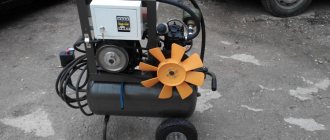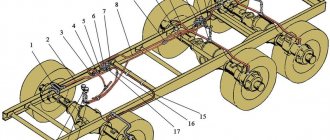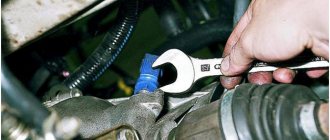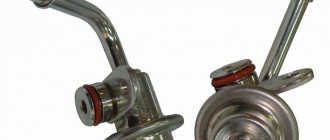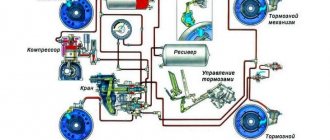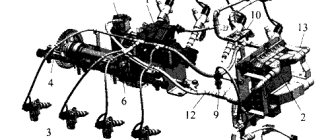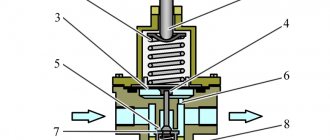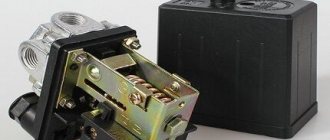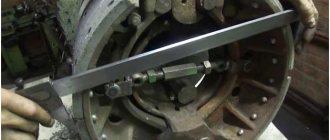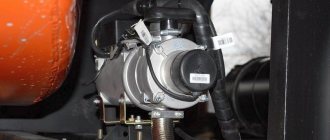9.1. Air Dryer.
An air dryer, shown in Figures 211 and 212, is installed in air brake systems to dry and clean the air coming from the air compressor and to regulate the operating pressure in the brake system.
Figure 211. External view and internal structure of the air dryer. Designations: 1 - Inlet; 2 - Control piston;3 - Outlet;4 - Channel;5 - Channel; 6 — Muffler;
7 — Exhaust; 8 — Exhaust valve; 9 — Moisture separation chamber; 10 — Check valve; 11 - Jet; 12 - Ring filter; 13 - Drying agent; 14 - Air regeneration receiver; 15 — Adjusting screw. Inlets: 1 - Supply inlet; 21 - Outlet (to the four-circuit safety valve); 22 — Branch (to the regeneration air receiver); 3 - Atmospheric output
The use of an air dryer eliminates the need to use moisture removal equipment based on additional cooling and automatic condensate drain valves, as well as additional antifreeze (alcohol) injection equipment.
The advantages of a dehumidifier over traditional air conditioning are as follows.
-There is no corrosion of brake system elements caused by condensation.
-The number of failures in the operation of components and assemblies of the brake system is reduced due to the absence of condensate and oil film.
- Low maintenance costs.
-Pressure regulation occurs in a zone of purified air, as a result of which the likelihood of malfunctions in the operation of the pressure regulator is reduced.
Air dehumidification occurs due to the adsorption of moisture at the molecular level by a drying agent (13). Compressed air is forced through the granular, highly porous powder. During this process, any water vapor in the air is deposited on the granules. To regenerate the powder, part of the dried air is discharged into the atmosphere, passing through the powder in the opposite direction. As a result of the decrease in pressure, the partial pressure of water vapor in the regenerating air (i.e., the dryest possible air) also decreases, which allows this air to absorb moisture deposited on the granules.
Figure 212. Structure of the dryer
Air dehumidification in the discharge phase.
The air supplied by the air compressor passes through the supply inlet 1 (the pneumatic circuit is shown in Figure 214) first through the ring filter (12), where it is pre-cleaned from contamination such as carbon deposits and oil. In addition, the air is cooled in the ring filter (12) and part of the moisture contained in it is collected in the moisture separation chamber (9). The air then passes through the granular powder (13) - where dehumidification occurs - to the check valve (10); opens it and passes through outlet 21 to the air receivers of the brake system. At the same time, through the jet (11) and outlet 22, a small air receiver (14) is filled for regeneration. Air purification and preliminary removal of moisture in the ring filter (12) has a positive effect on the service life and efficiency of the powder (13).
Air regeneration in the cleaning phase.
When the pressure in the brake system rises to an appropriate level, the so-called cut-out pressure, the integrated pressure regulator opens the relief valve (8). The air pumped by the air compressor and the compressed air from the air dryer are released into the atmosphere through the outlet (7) and the atmospheric outlet 3, while capturing the accumulated moisture, oil and most of the dirt particles settled in the filter.
Dry air from the regeneration air receiver (14) passes through outlet 22 and nozzle (11) and fills all free space. Penetrating through wet powder granules (13), air absorbs moisture deposited on the surface of the granules before being released into the atmosphere through the ring filter (12) and the discharge valve (8).
The check valve (10) prevents the reverse flow of compressed air from the air receivers.
Thanks to the integrated silencer (6), the noise generated when the dump valve (8) opens is significantly reduced. In this case, a multi-stage throttle muffler is used, the design of which protects against high-speed pressure pressure, which can cause contamination and thereby weaken the efficiency of the air dryer.
Operation of the integrated pressure regulator.
Due to the pressure in the receiver, the control piston (2) moves and the air passes through the channel (4). As soon as the pressure reaches the cut-out pressure, the control piston (2) moves to the right and opens the outlet (3). In this case, the control piston (2) closes the inlet (1) leading to the ventilation hole, no leakage occurs. As a result, compressed air is supplied through the channel (5) to the relief valve (8), opening it. As soon as the receiver pressure drops to the cut-in pressure level, the spring of the control piston (2) forces it to move to the left, thereby opening outlet (1) and closing outlet (3). The air above the exhaust valve (8) exits through the channel (5), inlet (1) and vent (15); the cleaning valve closes.
The shut-off pressure and excess pressure of the regulator are determined by the spring load and the movement of the control piston. Both values are achieved - largely independently of each other - by means of the adjusting screw 15.
In the event of a malfunction, the pressure regulator, the safety valve - consisting of a relief valve (8) and a valve compression spring (7) - ensures that the pressure in the receiver is limited, releasing the incoming air to the atmosphere as soon as the pressure reaches the opening pressure (emergency pressure).
To prevent freezing of the relief valve (8) under unfavorable weather conditions, use an electric heater installed in the air dryer body at the location of the relief valve (8) (not shown in the figures). The heater is turned on from the ignition switch, the temperature is controlled by an automatic built-in thermostat. Various modifications of the heater are possible. The heater is shown in Figure 213.
Figure 213. Appearance and internal structure of the heating element
When the ignition switch is turned on, the heating is controlled by a reverse current thermal relay. To prevent the battery from being discharged when the vehicle is parked, the heating current must be turned off when the ignition switch is turned off. The heater can be built in additionally.
Installing an air dryer increases the volume of the brake system (volume of the air dryer plus the regeneration air receiver). This increases the filling time of the brake system by approximately 3% to 7%. It is therefore necessary to check whether the permissible filling time of the brake system is being maintained.
In addition, the average duty cycle of the pressure regulator when installing an air dryer should not exceed 50%, since if the pumping time is increased, there may not be enough time for regeneration. At a duty cycle of 50% to 60%, it is not possible to install an air dryer.
Device
The air flow drying device includes such elements as:
- control type piston;
- release device;
- muffler;
- exhaust valve;
- moisture separator chamber;
- check valve;
- jet;
- ring filter element;
- pressure regulator and supply inlet;
- atmospheric output;
- fasteners for installation.
Air dehumidification is carried out by a compressor through which the air flow passes. The air then passes through a ring-type filter, where it is cleaned of carbon deposits and oil evaporation.
In the ring filter device, the air flow is cooled, due to which some of the moisture remains in the chamber of the drying device.
After the filters, the air passes through granular powder to a check valve. After it, it reaches the air receiver of the brake mechanism, passing through the outlets.
At the same time, the air receiver, which is used for regeneration, is filled through the nozzle and outlet. Cleaning the air flow and initially removing excess moisture in the annular filter element helps to increase the service life of the brake mechanisms.
How to install a dehumidifier
In order to install this device, you will need the following tools:
- wrench;
- welding machine;
- screwdriver;
- hammer.
Before installing an air dryer on a KamAZ truck, it is recommended to wear safety glasses and a mask to avoid injury.
Connection diagram and procedure during installation of the device:
- Place the vehicle on an inspection pit or platform for repair work.
- Unscrew the fasteners and remove the vehicle bracket.
- Remove the radiator from the car body.
- Remove the O-rings and gasket.
- Using the mounting bolts, screw the dehumidifier to the support frame.
- Connect the pipe that comes from the compressor housing to the dryer.
- Conduct an external inspection of the membrane density.
- Check the check valve.
- Check the pressure level in the system and the degree of air compression.
- Check the functionality of the condensate drain valve.
- Install the O-rings on the filter device.
- Screw on the top cover.
- Reinstall the radiator and bracket.
After these steps, it is recommended to start the engine and check the operation of the entire brake system.
bad blood pressure | Topic started by: Miyuki
Salute to all KAMAZ drivers! The following problem appeared: on the KamAZ it became difficult to pump air into the system, up to 5.5 at idle it pumps normally, and above that it is already difficult and very slow.
Andrey (Coronis) look at the cut-off valve. Although most likely the compressor is “ales kaput”
Olexiy (Fasih) Possibly different, this happened to me because of the valves (in the compressor)
Evgeny (Quon) definitely for the compressor
Alexander (Yoshio) look at all the tubes, maybe there’s a break, I had it like that until 5, it shakes and that’s it, I’ve been looking for where the hiss is for a long time
Mister (Tallulah) is not a pipe, It’s a valve, or rather a discharge valve, It’s being bent by the bastard
Anatoly (Gaetano) guys, I have a problem, help, it pumps air only at high speeds and ate, ate, two presses of the brake pedal, and the whole car releases the brakes! what to do??
Niaz (Sudhi) what is the cost of the compressor?
Artur (Wambua) press the outlet of the air compressor through a rag with your thumb, if you don’t hold the pressure, then the RDV is fucked!
Arthur (Wambua) I came across this. I installed 3 new compressors and no show off. there was a reason for everything in the Russian Far East
Seryoga (Lilia) please tell me yesterday I started constantly relieving the pressure of the soldier EVEN WITH 2 GLASSES IT WORKS. today I did it directly, the compressor barely pumped up 6, what could it be
Evgeny (Quon) The condensate in the tubes is frozen, most likely, if the copper tubes take a blowtorch in your hands and go and warm them up! And pour dehumidifier into the alcoholic, everything should be fine! )
Kamil (Alexandrina) The new Kamaz pumps up to 5'5. I changed the compressor, changed the hose pump, changed the triple counting valve. It doesn't pump. One of the receivers is humming.
Ruslan (Andongwisye) Salute to all drivers! Such a problem, it pumps air up to 6 atmospheres, then, well, not like, before and after the soldier it pumps the same way, maybe someone can tell me. Thank you in advance!
Andriy (Shayla) Guys help solve this problem on KAMAZ, the lower scale pumps air 8 and the upper one 4, so in just over an hour you can pump nothing.
Ilfat (Pravin) Could the compressor pump poorly due to the water separator filter? if it is clogged for example.
Sasha (Wehilani) Hello everyone. The problem is this: the compressor is working, I checked all the tubes, but the air is not pumping, what should I do?
Sasha (Wehilani) Hello everyone. The problem is this: the compressor is working, I checked all the tubes, but the air is not pumping, what should I do?
Dinar (Anoushig) Sasha, isn’t he pumping anymore?
Ranis (Shakambhari) Dinar, I have such a situation, I installed a new compressor, it pumps 1 point and drives oil! what's the matter? please tell me if you know!
Operating rules
In order for the air regeneration device to function without failures, it is necessary to carry out timely maintenance in accordance with the user manual. It is also recommended to inspect the device daily for damage and defects.
In order to check the safety valve of the equipment, you need to tighten the hollow screw of the regulator until it stops. If the mechanism is working properly, then at pressure “A” the outlet valve will open, which must be sealed during the switching interval.
The check valve is serviced using a pressure gauge. If the pressure level drops to 0 bar, it is necessary to disassemble the mechanism and check the integrity of the parts.
In order to diagnose the drying device, you should lower the pressure level and determine the switching interval “C”. If the readings exceed the norm, it is recommended to turn the screw to the left, and if the readings are below the norm, to the right. After all the lock nuts have been tightened, you need to check the adjustment of the adjusting device again.
When air flow is applied to the terminals, a leak of 10 cm per minute is allowed, and the minimum pressure level in the system can drop to 1 bar.
Malfunctions and repairs
In some cases, repairs may be required; malfunctions may be caused by leaks in the brake system. The device stops automatically removing moisture and condensation. In this case, the O-ring and springs may need to be replaced.
Troubleshooting procedure:
- Remove the bracket using a wrench.
- Unscrew the fasteners from the radiator dryer.
- Carry out an external inspection of the O-rings and clean the surface of the air dryer. If necessary, replace worn elements.
- Remove the screws of the drive cover.
- Separate the cover from the body and replace the gasket.
- Remove the thrust ring and lock washer.
- If the membrane of the sealing ring mechanism has lost its seal, replace it with a new one.
- If air constantly hisses from the drain hole, replace the cuffs by removing the thrust washer from the rod.
- Check the condition of the bypass valve and spring for wear.
All repair work must be carried out by placing the vehicle on a special platform and turning off the power unit.
The price for repairing a moisture separating device ranges from 1000 to 2000 rubles.
A compressor is installed on all Kama-made trucks. KamAZ 5320 is no exception. This element not only pumps air, but is also a source of oil and moisture accumulation in the system. Therefore, for its normal operation, an additional moisture separator (KAMAZ) is installed. The principle of operation, its structure and varieties are further in our article.
Reviews and prices
The average cost of the Russian Far East is 4,500 rubles.
Mikhail, 36 years old, Izhevsk: “I have been working as a KamAZ driver for 6 years. During the entire period of operation, the air pressure regulator in the pneumatic system failed several times. On average, repairs take about one to two days. In order for the mechanism to break down less often, I recommend using high-quality fuel.”
Alexander, 49 years old, Lipetsk: “I work in a service center. Cars are often brought in for repairs with a non-functioning air pressure regulator. This mechanism fails if maintenance is not carried out on time and the oil in the system is not regularly changed. I also recommend cleaning the filters at least once a month.”
Evgeniy, 53 years old, Voronezh: “I work at KamAZ 45143. The regulator failed only 2 years after the start of operation of the vehicle. First, an air leak began, and then the device stopped switching the compressor to the desired operating mode. I did the repairs myself according to the instructions, no difficulties arose.”
Konstantin, 46 years old, Leninsk: “In order to repair the regulator, I recommend using a special device that helps adjust the pressure level. Before connecting equipment to this device, it is required to carry out an external inspection of the regulator for the presence of any damage or defects.”
Peter, 50 years old, Krasnodar: “I have repaired the regulator at KamAZ 3 times already. The cause of failure is always clogged filter elements and damaged cuffs. In order to avoid malfunctions, I recommend changing the O-rings once every 3 months and regularly carrying out vehicle maintenance.”
How do you like the performance and durability of the air brake system? Are you satisfied with its service life?
We also recommend paying attention to the pneumatic valve, solenoid valve and damper mechanism.
If a malfunction is detected, we recommend contacting a service center to diagnose and understand the problem. An independent solution can lead to more serious damage.
Where can repairs be made?
- 1) On site (on-site visit of a specialist within Moscow and Moscow Region)
- 2) Service center in Podolsk (Pleshcheevskaya street, 30B)
- 3) Service center in Moscow (Skotoprogonnaya st., 33A, building 1)
Timely troubleshooting will save you from additional waste and major repairs.
About the braking system
All modern trucks now use a pneumatic drive system. It is also a source of compressed air for other process units. The use of a pneumatic system is determined by its high reliability, versatility and efficiency.
This design is designed in the same way. It definitely includes a compressor. KamAZ is also equipped with receivers, pipelines, actuators and valves. In addition, this system includes a moisture separator. KamAZ (Euro-3) is equipped with it at the factory.
There are four main malfunctions that lead to disruption of the brake systems:
- malfunction of the protective valves, - clogging or leakage of receivers, pipelines and hoses, - piston rings and sensors are not working properly, - compressed air leaks.
In order to prevent possible malfunctions in the KAMAZ brake system, it is necessary to timely check the operation of its systems. This can be done once every two years. So, below is a list of possible malfunctions of the KAMAZ brake system and ways to eliminate it.
There is a lot of oil in the pneumatic system.
Wear of piston rings. Remedy: replace the compressor.
Receivers of circuit 1, 2 and 3 are not filled with air.
Cause: The supply tubes are clogged. Remedy: simply blow out the tubes, and if foreign objects are found there, remove them. Cause: The safety valve is broken. Remedy: change the valve.
Pneumatic system receivers fill very slowly or do not fill at all.
Cause: Tubes, hoses or adapter and connecting equipment are not tightened sufficiently. Remedy: Tighten the places where the parts are connected, if necessary, replace uncorrected parts. Reason: the receiver or device is not hermetically sealed. Remedy: change the receiver, device. Cause: The air supply hoses and tubes are damaged. Remedy: Replace hose and tube assemblies. Cause: Compressor performance is low Remedy: Check the compressor if it needs to be replaced. Reason: presence of dents on the surface of the air outlet or air supply bosses. It is noticeable to a large extent that the surfaces are not perpendicular to the axes of the holes in the threads. Remedy: sand out small nicks and dents. Eliminate the problem of non-perpendicularity.
In the receivers of circuits 1 and 2, increased or decreased pressure is observed while the pressure regulator is operating.
Cause: The pressure regulator is not adjusted correctly. Remedy: make adjustments using the adjusting screw, if necessary, replace the regulator. Cause: broken 2-pointer pressure gauge. Remedy: replace the pressure gauge.
The car brakes poorly or there is no braking when the brake pedal is pressed.
Cause: Compressed air leak. Repair air leak.
Poor vehicle braking or lack of braking.
The cause is clogged circuit 3 hoses or tubes. Remedy: clean the tubes and then blow them with compressed air. If necessary, replace it. Reason: Spring energy batteries do not work. Remedy: replace the spring energy accumulator and brake chamber. Cause: The relay valve is faulty. Remedy: Replace faulty parts. Reason: increased rate of stroke of the brake chamber rods. Remedy: adjust the stroke of the rods
Purpose
This element performs the function of removing oil and moisture, the presence of which can greatly affect the further operation of the compressor. By the way, it is the basis of any KamAZ brake system. It is through this that air is pumped under high pressure.
However, there are elements in the system that need lubrication. Therefore, during operation, air accumulates in the middle of the device. And since oxygen for the system is taken from the atmosphere, it contains a certain percentage of moisture. Its presence on highways is simply unacceptable. The slightest drops of water settling on the surface of the valves quickly damage the compressor. KamAZ will brake poorly. Also, the presence of moisture accelerates corrosion processes. Outwardly, these factors are extremely difficult to notice; this is only possible when the emergency air pressure lamp lights up on the instrument panel.
Triple safety valve Kamaz
The triple safety valve serves to divide the line from the compressor into three autonomous circuits - two main (front axle wheel brake drive and rear bogie wheel brake drive) and one additional (emergency brake release system drive), as well as to automatically shut off the damaged circuit in order to maintain pressure in good circuits
The triple safety valve consists of a body 1, three covers 2, three valves 3, 6 and 8, three diaphragms 5 and two bypass valves 7.
Rice. 1. Triple safety valve: 1 - body, 2 - cover, 3,6,8 - valves, 4 - spring, 5 - membrane, 7 - bypass valves
Compressed air from the compressor through the housing outlet enters cavities A and B under valves 3 and 6.
When the pressure in the cavities reaches 520 kPa, valves 3 and 6, overcoming the forces of the balancing springs 4 and bending the membranes 5, open.
Compressed air through terminals I and II is directed to the receivers of the brake drive circuits of the front axle and rear bogie wheels, respectively.
Simultaneously with the start of filling the receivers, valves 7 open and air enters the cavity above valve 8.
When the pressure reaches 510 kPa, valve 8 opens and compressed air fills the circuit of the emergency brake release system.
When the pneumatic drive circuits are in good working order, the membranes 5 additionally bend under the influence of air pressure in cavities A, B and C. Therefore, valves 3, 6 and 8 are open even when the pressure in these cavities is below the specified value.
If one of the circuits fails, for example circuit I , the pressure in the internal cavity of the faulty circuit (in terminal I ) decreases and, under the action of spring 4, valve 3 closes.
But since in the cavity there are 3, 6 and 8
air continues to flow from the compressor, and the membranes of the serviceable circuits are affected by compressed air from the receivers, valves 6 and 8 of the serviceable circuits open at a pressure less than the opening pressure of the valve in the faulty circuit, and no air will flow into the leaking circuit.
When the air pressure at the inlet to the valve body reaches above the set value, the valve of the leaky circuit will open and excess air will be released into the atmosphere, i.e., in the sealed circuits the pressure will be maintained corresponding to the opening pressure of the valves of the leaky circuit (520 or 510 kPa).
If the line coming from the compressor fails, valves 3, 6 and 8 are closed under the action of springs 4 and the pressure in the pneumatic drive circuits is maintained.
Receivers serve to accumulate compressed air and supply it to brake pneumatic drive devices, as well as to power other consumers and vehicle systems.
The cars are equipped with six receivers with a volume of 20 liters each, four of them are connected in pairs, forming a single volume of 40 liters. The receivers are installed on the car frame brackets and attached to them with clamps.
Varieties
Today, the KamAZ water separator can be of two types: with the RDV - a built-in air pressure regulator, or without it. These devices have the same purpose. However, their design is different. It is believed that devices with a built-in air pressure regulator provide more reliable operation of the pneumatic system. In addition, their design may include a radiator. Such elements use a combined type of air filtration - thermal and simply dynamic. The KamAZ water separator without a radiator has only the last type of drying. The element itself is a thin-walled ribbed tube, rolled into 5-6 turns.
Heating method
The filter-moisture separator also differs in the heating method. Depending on it, it can be electrical or mechanical. The design of the first type of device includes a built-in heating element. It releases the valves during winter operation. As for devices with mechanical heating, they operate using hot air energy. They also have anti-freeze valves in their design. They ensure smooth operation of the system until the brake is released.
Device
Regardless of the type, the structure of these elements is the same. The filter-moisture separator is based on a metal body with a guide vane and a moisture release valve. There are also additional valves: a safety valve, which ensures uninterrupted operation of the device when moisture freezes in the radiator, and a return valve. The latter prevents pressurized air from flowing back to the compressor from the system.
It is worth noting that the KamAZ moisture-oil separator, depending on the type of design, has different condensate collection valves. On devices without an air pressure regulator, this is a diaphragm spool version. It opens due to air discharge when the regulator is activated. As for devices with RDV, their design includes one spring-type valve. It opens simultaneously with the pressure regulator.
What pressure is considered nomative?
The quantity and degree of compression of air pumped into the cylinder must be as indicated in the specialized table attached and the instruction manual. On a metal plate attached to the cabin doorway. If the data is unreadable or the plate is missing, make sure that you always have a printed memo in your glove compartment, which indicates what pressure should be in the tires of your Kamaz.
The table shows the relationship between tire size and standard pressure. It also depends on the axle load. Different models have different pressures. Thus, the lightweight KamAZ 43118 rides on wheels with less inflation than the heavy truck KamAZ 65115. But in some cases it is even recommended to artificially lower the tire pressure.
How does a KamAZ water separator with a regulator work?
The operating algorithm of the device has certain features in the moisture collection mechanism. The compressor pumps air and directs it through pipelines to the radiator. There it is dried and cooled. The air then enters a spiral-shaped channel located between the water separator housing and the regulator. Here it undergoes a cleaning procedure. Then, through the check valve, it again enters the system, but in a form suitable for use.
At this time, the moisture itself accumulates at the bottom of the device’s body. Having reached the extreme value, the condensate is removed. At the same time, the regulator valve opens, which in turn activates the moisture release valve. At this time, the radiator is purged. Inside it, all moisture from the water is cleaned out with high pressure.
Problems at work
They can occur in winter. At sub-zero temperatures, during long periods of inactivity, the relief valve may simply freeze. The pressure regulator then works as a safety element, providing pressure relief when a critical level is reached. However, when the compressor starts, hot air enters the dehumidifier. KamAZ, idling for about 5-10 minutes, will be suitable for operation, since this air, at its temperature, completely warms the valve and restores its operation.
Pressure Regulator Maintenance
It consists of periodically checking its operation and cleaning the filter (during seasonal maintenance). Replacement of rubber valve seals (repair kit). Pressure adjustment.
If the limits of the adjustable air pressure in the pneumatic system do not correspond to 0.65 0.8 MPa (6.5 8.0 kgf/cm), (: using the adjusting bolt, you should adjust the pressure to the required limits. In order to remove the filter, you must unscrew bottom cover 1. After this, you need to rinse the filter in gasoline and clean the internal cavities of the regulator and cover.
WATCH THE VIDEO
Advantages
As for the advantages of using devices with a pressure regulator, we should note the high efficiency of moisture removal. A conventional device without a regulator, especially in winter, is not able to completely clear the air of oil and moisture due to poor valve operation. This significantly reduces the efficiency of the air brake system.
In a device with a regulator, moisture removal is accompanied by purging of the radiator and housing under pressure - the moisture evaporates and is perfectly discharged into the atmosphere. Therefore, before installing a water separator on KamAZ, you need to understand the operating principle of both types of elements. As you can see, the most suitable option is with an air pressure regulator. This is installed on most foreign-made trucks. Therefore, its presence on the domestic KamAZ will not be superfluous.
Pressure regulator: air pressure is always normal
September 12, 2014
Trucks use a pneumatic system to operate the braking system and many other mechanisms. The pneumatic system includes many components, among which the pressure regulator plays a special role. Read about the pressure regulator, its design, operating principle, applicability and malfunctions in this article.
Purpose and location of the pneumatic system pressure regulator
On domestic and foreign trucks, a pneumatic braking system is widely used, which also supplies compressed air to a number of other components and assemblies - the dump platform control system, clutch, sound signal, etc. All these components are built in such a way that they work normally only within a certain pressure range, and if the pressure goes beyond this range (becomes higher or lower), then their operation will become impossible. And an excessive increase in pressure is even fraught with breakdowns.
Operating rules
This item requires minimal maintenance during use. But we will note several features, knowledge of which will significantly extend the life of the moisture-oil separator. First, you need to install it correctly. The drain hose must point straight down. Thus, the collected condensate will be directly and unhinderedly discharged outside. If the fitting is moved to the side, even at high pressure some moisture will remain, which will provoke corrosion processes inside the elements.
Also, do not forget about the tightness of the system. If you install a used separator, it is advisable to purchase a repair kit and change the sealing elements. Otherwise, this device has high reliability and operational efficiency, protecting the rubber diaphragms of the brake chambers from the harmful effects of oil, and the valves from corrosion and freezing in winter.
It can only be faulty if it is depressurized. For example, if he began to “poison” the air frequently. In this case, the problem is solved by purchasing a repair kit. It includes a set of springs, rubber O-rings and cuffs. By the way, if the latter malfunctions, the device constantly “hisses”, letting some of the air out under pressure.
Malfunctions of pneumatic drive power supplies
When servicing the pneumatic drive of the car brakes, you must first make sure that the system is tight. Particular attention should be paid to the tightness of connections of pipelines and flexible hoses, since this is where air leaks most often occur.
Places of strong air leakage are determined by ear, and weak ones - using a soap emulsion.
Air leaks from connections of pipelines and brake system devices are eliminated by tightening them, and leaking pipelines and flexible hoses are replaced. It must be remembered that on cars manufactured since March 1986, pipeline connections are sealed using rubber rings, so the tightening torques of the fittings should be less (Table 1).
If the air cylinders of the brake pneumatic drive are not filled and the pressure regulator vents air into the atmosphere, there may be several reasons:
— the pipeline between the regulator and the safety valves is blocked;
- the pressure regulator is faulty - most often the filter element in it is clogged with oil or ice crystals.
pipeline diameter, mm.
Tightening torque, kgcm
If the air tanks fill slowly and the air pressure does not reach the nominal pressure, then either the compressor or the pressure regulator is faulty. A malfunction of the compressor cylinder-piston group is also indicated by an increased oil content in the condensate.
Often the cylinders of a separate circuit are poorly filled. The air in each circuit of the brake system passes through a section of its “own” safety valve. Probably, the safety valve does not allow air into the cylinder or the air supply line to this circuit is clogged. It is also possible that the standard two-pointer pressure gauge is faulty.
